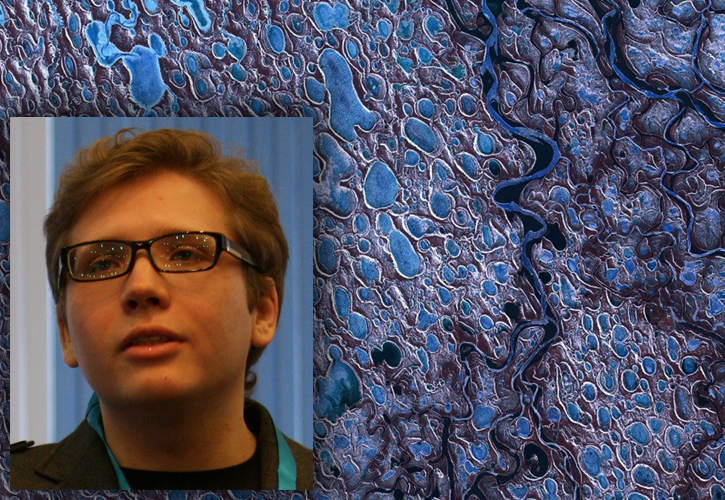College of Arts and Sciences Newsroom

University of Dayton physicist receives AI for Earth grant from Microsoft
By Dave Larsen
University of Dayton physicist Ivan Sudakow was awarded an AI for Earth grant from Microsoft to help further global research efforts in Arctic climate change.
The grant provides Sudakow with machine learning tools and cloud computing services to accelerate his work on an algorithm to identify tundra lakes in satellite images of land surfaces using image segmentation. The process involves dividing a visual input into segments to simplify image analysis.
Tundra lakes are key components of the Arctic climate system because they represent a source of methane to the atmosphere, and they change shape and increase in size as permafrost thaws. Sudakow’s work develops a novel and independent approach to image segmentation of tundra lakes using deep neural learning for future goals such as the estimation of greenhouse gas flux from permafrost surface, the detection of tundra lakes erosion, and identification of potential disruption of infrastructure on permafrost.
The one-year grant started May 1 and provides Microsoft services, consulting and support, including Microsoft Azure cloud computing credits worth $15,000.
“Microsoft Azure includes many services, but machine learning tools and data management are the most important tools for me,” said Sudakow, assistant professor of physics. “I will be a member of the AI for Earth Community where they will provide training, webinars and the space for collaboration with the Microsoft team. Weekly office hours with Microsoft experts are also available.”
AI for Earth is a $50 million, 5-year program that brings the full advantage of Microsoft technology to those working to solve global environmental challenges in the key focus areas of climate, agriculture, water and biodiversity. Through grants that provide access to cloud and artificial intelligence (AI) tools, opportunities for education and training on AI and investments in innovative, scalable solutions, AI for Earth works to advance sustainability across the globe.
“Ivan Sudakow is one of the newest researchers to be recognized by Microsoft for his impact and potential, and will join a growing number of AI for Earth grantees worldwide,” the company said in the grant announcement.
Recognizing tundra lakes in satellite images is complicated and requires a human expert who can measure the exact area of a lake in a diverse landscape of tundra. Because the human eye can’t process thousands of images, some researchers apply ‘supervised machine learning,’ in which an expert develops a training set used by the AI for pattern recognition.
Sudakow is taking the opposite approach by using SegNet, a deep convolutional encoder-decoder architecture for image segmentation developed by members of the Computer Vision and Robotics Group at the University of Cambridge, UK.
“In unsupervised machine learning — for example, the algorithm SegNet that we will also use in this research — the AI would not use a labeled training data,” he explained. “Instead, it is teaching itself how to recognize the patterns, increasing and increasing ‘learning material.’ At each iteration, it is going to be more experienced and see more and more ‘patterns.’ In this project, we need to develop unsupervised machine learning methods for tundra lakes recognition.”
Sudakow developed supervised machine learning for tundra lakes recognition with his former graduate student, Almabrok Essa ’17. In 2017, Sudakow, Essa and current doctoral student Ming Gong ’15 published a paper in the journal Remote Sensing, in which they analyzed the geometry of patterns formed by large tundra lakes in the Russian High Arctic, using historical maps and satellite images. This collaboration continues with Vijayan Asari, director of UD's Vision Lab.
Using Microsoft Azure with this project will help reduce computer programming time because many processes are determined and automated. As Sudakow put it: “Just ‘clicks,’ no command line.” He also plans to discuss Azure this summer in his computational physics course for computer science master’s degree students.
Artificial intelligence is now a major research focus in a number of professional areas, and faculty across the sciences and engineering have a strong interest in AI and machine learning, said John Erdei, associate professor and Department of Physics chair.
“As a result, this grant can act as a seed to foster on-campus professional interactions and growth in this highly active area of research,” Erdei said. “This is a tremendous opportunity for Dr. Sudakow to further his research agenda and initiate collaborations with others who have an interest in AI research.”
For more information, visit the Microsoft AI for Earth website.
The satellite image above shows tundra lakes in Central Yakutia, Russia. Provided by ScanEx.
